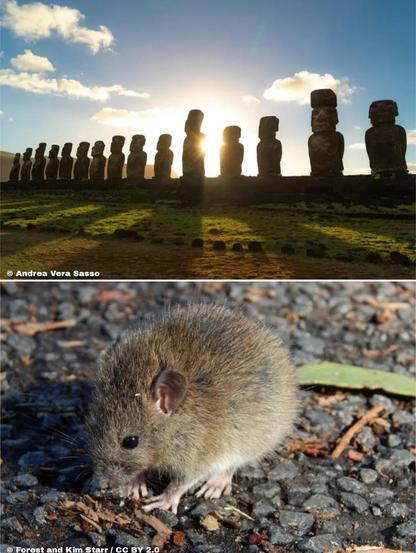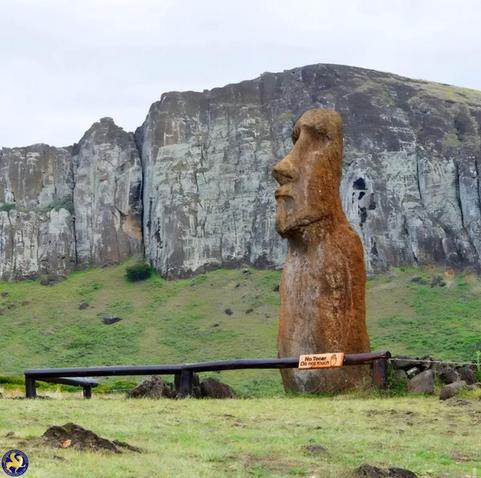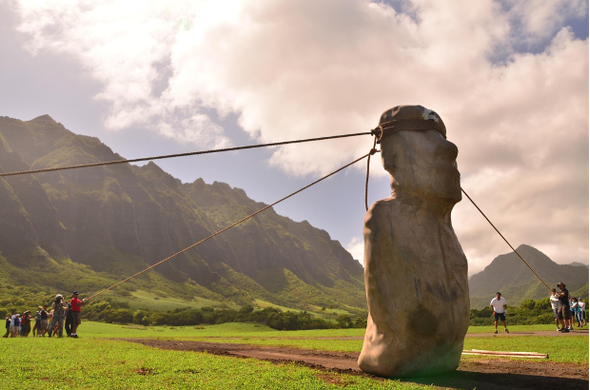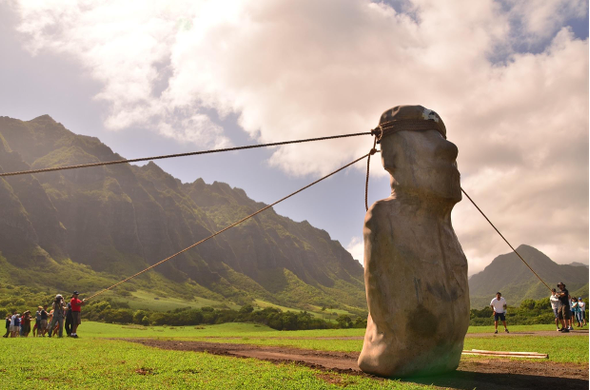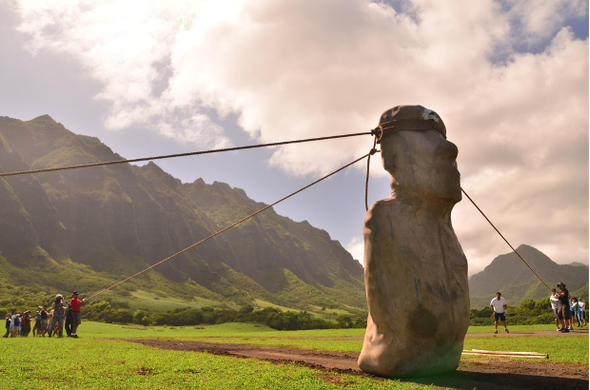Unintended Consequences : Treeless Rapa Nui
#rapanui
Inicia el Panamericano de Va’a Rapa Nui 2025: amor al mar, la cultura y el deporte | vía #UChileRadio
#brasil #ceremoniaclausuraparapanamericanos #chile #panamericanodevaa #perú #rapanui
Rats and the fall of Rapa Nui’s forests: invasive species, not humans, drove the island’s deforestation
A new study published in the Journal of Archaeological Science, reexamines the causes of Rapa Nui’s dramatic deforestation and highlights the role of the introduced Polynesian rat (Rattus exulans)...
More information: https://archaeologymag.com/2025/11/rats-and-the-fall-of-rapa-nuis-forests/
Follow us @archaeology
Île de Pâques : le mystère #RapaNui enfin résolu ?
youtu.be/1KdoQfn2ysc
Île de Pâques : le mystère Rap...
"The scientists collected sediment cores from two of the island's few freshwater sources: Rano Aroi, a high-elevation wetland and Rano Kao, a crater lake. By analyzing the hydrogen isotope composition of plant leaf waxes within those cores, the team reconstructed a continuous, 800-year record of past rainfall trends, showing that annual precipitation declined and remained low for more than a century.
Published in the journal *Communications Earth & Environment*, their findings challenge long-held narratives of societal 'collapse,' instead showing that Rapanui communities were resilient to profound climate stress. Columbia Climate School spoke with lead author Redmond Stein about how the team uncovered this history and what it means for understanding the links between climate and culture."
https://phys.org/news/2025-11-easter-island-ancient-sediments-rewrite.html
A new study argues that rats, not just people, drove Easter Island’s deforestation. A few stowaways exploded into millions, gnawing through the island’s future—one palm seed at a time. #Archaeology #IslandEcology #RapaNui #Anthropology https://www.anthropology.net/p/rats-palms-and-the-fall-of-a-forest
Legends of Easter Island (NOVA 1989)
https://mprove.de/chrono3d?ll=0,0&m=HL10773976&o=0.15&s=1&c=,i,I
#HierSoAufDemSchirm #Glasperlenspiel #ChronoMedia #EasterIsland #rapanui
Easter Island’s moai statues really “walked”: physics and archaeology confirm the hypothesis
For centuries, researchers have been captivated by the mystery of how the ancient inhabitants of Rapa Nui—also known as Easter Island—transported their huge moai statues. Now, new research using physics, 3D modeling, and field experiments presents the strongest evidence...
More info: https://archaeologymag.com/2025/10/easter-islands-moai-statues-really-walked/
Follow us @archaeology
#archaeology #archeology #archaeologynews #moai #rapanui #easterisland
#Indigenous #RapaNui #antibiotics #rapamycin
"An antibiotic discovered on Easter Island in 1964 sparked a billion-dollar pharmaceutical success story. Yet the history told about this “miracle drug” has completely left out the people and politics that made its discovery possible.
Named after the island’s Indigenous name, Rapa Nui, the drug rapamycin was initially developed as an immunosuppressant to prevent organ transplant rejection and to improve the efficacy of stents to treat coronary artery disease. Its use has since expanded to treat various types of cancer, and researchers are currently exploring its potential to treat diabetes, neurodegenerative diseases and even aging. Indeed, studies raising rapamycin’s promise to extend lifespan or combat age-related diseases seem to be published almost daily. A PubMed search reveals over 59,000 journal articles that mention rapamycin, making it one of the most talked-about drugs in medicine.
Despite being so ubiquitous in science and medicine, how rapamycin was discovered has remained largely unknown to the public. Many in the field are aware that scientists from the pharmaceutical company Ayerst Research Laboratories isolated the molecule from a soil sample containing the bacterium Streptomyces hydroscopicus in the mid-1970s. What is less well known is that this soil sample was collected as part of a Canadian-led mission to Rapa Nui in 1964, called the Medical Expedition to Easter Island, or METEI.
As a scientist who built my career around the effects of rapamycin on cells, I felt compelled to understand and share the human story underlying its origin. Learning about historian Jacalyn Duffin’s work on METEI completely changed how I and many of my colleagues view our own field.
Unearthing rapamycin’s complex legacy raises important questions about systemic bias in biomedical research and what pharmaceutical companies owe to the Indigenous lands from which they mine their blockbuster discoveries."
How Easter Island’s giant statues “walked” to their final platforms https://arstechni.ca/c7Tu #experimentalarchaeology #anthropology #easterisland #Archaeology #Science #Physics #rapanui
Study Confirms Rapa Nui Statues Were Moved Upright Using Rocking Motion
Sure, fancy science, but who really benefits from these tales?
Study Confirms Rapa Nui Statues Were Moved Upright Using Rocking Motion
Yeah, blaming academics for ‘spinning tales’ is just lazy thinking. The evidence's solid—statues weren’t slid flat but rocked upright. Dismissing native ingenuity as 'just logs' ignores real history and the Rapa Nui’s cleverness.
Study Confirms Rapa Nui Statues Were Moved Upright Using Rocking Motion
Pfft, rocking statues? Sounds like academics spinning tales to dodge real history. Those moai probably just slid on logs, but sure, let’s hype up some fancy zigzag dance.
Un equipo de investigación liderado por el arqueólogo Carl Lipo de la Universidad de Binghamton ha confirmado que las estatuas moai de la Isla de Pascua, conocidas como Rapa Nui, fueron transportadas mediante un movimiento de balanceo en zigzag utilizando cuerdas y caminos diseñados específicamente.... [Ver más]
Study Confirms Rapa Nui Statues Were Moved Upright Using Rocking Motion
Researchers including Binghamton University archaeologist Carl Lipo have confirmed through 3D modeling and field experiments that the ancient Rapa Nui people moved the massive moai statues by making them 'walk' in a controlled rocking, zig-zag motion. This challenges earlier theories which suggested... [More info]
Study Confirms Rapa Nui Statues Were Moved Upright Using Rocking Motion
Yeah, right, like ancient folks needed physics lessons to move giant rocks. Sounds like more made-up fairy tales to me.
Osterinsel: Moai-Statuen „schunkelten“ an ihre Plätze. Feldexperiment enthüllt Transporttechnik der riesenhaften Steinstatuen. #Osterinsel #Moai #RapaNui #Archaeologie #MoaiStatuen
https://www.scinexx.de/news/archaeologie/osterinsel-moai-statuen-schunkelten-an-ihre-plaetze/
🗿⚖️ Researchers at #Binghamton University used #physics modeling and field experiments to confirm that #EasterIsland's massive #moai statues were transported upright using rope teams that "walked" them in a coordinated rocking motion along specially designed roads. The team successfully moved a 4.35-ton replica statue 100 meters in 40 minutes with just 18 people, validating the efficiency of this ancient #engineering technique.
👉 https://phys.org/news/2025-10-easter-island-statues-physics.html
👉 Moai on TKSST: Walking with Giants: How did huge stone moai move across #RapaNui?
https://thekidshouldseethis.com/post/walking-with-giants-moving-rapa-nui-moai-videos
Physics meets Polynesian ingenuity: new research confirms that Easter Island’s moai “walked” upright across the landscape using balance, rhythm, and rope—turning myth into mechanics. #Archaeology #RapaNui #AncientEngineering #Science https://www.anthropology.net/p/when-giants-walked-how-rapa-nuis
A billion-dollar drug was discovered in soil samples from Easter Island decades ago, but the question remains — what do scientists and pharmaceutical companies owe the Indigenous Rapa Nui people whose land and knowledge were drawn upon?
This case highlights the urgent need for fair benefit sharing, ethical research practices, and genuine respect for Indigenous sovereignty when global industries profit from local resources.
#indigenousrights #scienceethics #bioprospecting #rapanui #rapamycin #multinationals #bigpharma

